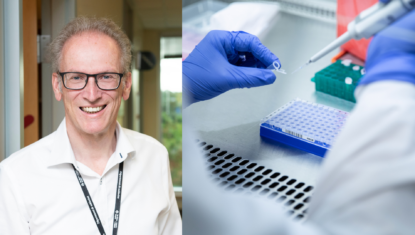Neurology is the branch of medicine concerned with the study and treatment of disorders of the nervous system. The nervous system is a complex, sophisticated system that regulates and coordinates body activities. It has two major divisions: The central nervous system: the brain and the spinal cord.
A general practice doctor might make a referral to a neurologist if they believe that an individual shows signs of a neurological problem. Neurological issues encompass a broad range of conditions, including Alzheimer’s disease, diabetic neuropathy, headache, and nerve damage.
Related News
Research Projects
-
Number of epilepsy surgeries has decreased despite an increase in pre-surgical evaluations at a tertiary pediatric epilepsy center in Ontario
12/04/2023
Despite an increasing trend in pre-surgical evaluation, there was a decreasing trend in the number of epilepsy surgery in the later period as there was a larger proportion of patients in whom the seizures could not be localized. Trends in presurgical evaluation and epilepsy surgery will continue to evolve with introduction of technologies such as stereo-EEG and minimally invasive laser therapy.
-
Real-time detection of neonatal seizures improves with on demand EEG interpretation
11/11/2022
Combining aEEG with on-demand cEEG interpretation improved accurate seizure detection in a high-risk NICU population, with the potential to avoid over-treatment.
-
Tremor Presenting in Infants and Children Aged less than 2 Years
18/01/2022
Tremor with onset at age <2 years follows a benign course, with many patients requiring no treatment and outgrowing the disorder.
-
Genomics in Cerebral Palsy phenotype across the lifespan: Comparison of diagnostic yield between children and adult population
21/07/2021
Major conclusions: Given the combined high yield of positive genetic diagnosis in pediatric and adult cases presenting with symptoms of Cerebral Palsy, and the more readily available Next Generation Sequencing testing in major academic centres, we recommend that either a referral to a pediatric or adult neurometabolic centre to be made, or genetic testing to be initiated where this is available.
-
Potential Benefit of Add-on Δ9-Tetrahydrocannabinol in Pediatric Drug-Resistant Epilepsy: A Case Series
29/06/2021
Based on our experiences and reports in the literature, we propose that, in patients who fail management with an initial trial of high-dose CBD-focused therapy, there may be a role for add-on THC-focused formulations.
-
Multidisciplinary Practice Variations of Anti-Thrombotic Strategies for Free Tissue Transfers
23/06/2021
There are diverse practice variations in anti-thrombotic strategies for free tissue transfers and a difference in perceived risk factors for flap failure that may affect patient management.
-
Bibliometric Analysis of Neurology Articles Published in General Medicine Journals
15/04/2021
Compared with other specialties, neurology-based articles are published more frequently in general medicine journals.
-
Not so Shocking: Electromyography in Pediatrics Remains Feasible and Diagnostically Useful
01/01/2021
Overall NCS/EMG is well tolerated and able to be performed without sedation in children of all ages.
-
Continuous EEG in a pediatric intensive care unit: adherence to monitoring criteria and barriers to adequate implementation
01/01/2021
we strongly advocate for a routine screening for cEEG monitoring indications as part of the PICU admission process, and a care model allowing for cEEG initiation around-the-clock.
-
Tuberous sclerosis complex associated intracranial lesion found by antenatal ultrasound
22/04/2020
Though there are no reports of sensitivity of neurosonography for the antenatal detection of intracranial abnormalities associated with TSC, our case suggests that antenatal ultrasound could be used as a screening modality for antenatal diagnosis of TSC.
-
PLPHP deficiency: clinical, genetic, biochemical, and mechanistic insights
01/03/2019
The vitamin B6-responsive disorders (B6RDs) are a clinically and genetically heterogeneous group of rare, autosomal recessive conditions (Clayton, 2006) with the hallmark feature of seizures uniquely responsive to treatment by the B6 vitamers pyridoxine and/or pyridoxal-5′-phosphate (PLP) (Baumgartner-Sigl et al., 2007; Basura et al., 2009). PLP is a cofactor for over 160 distinct catalytic functions (Percudani and Peracchi, 2009), including enzymes involved in glucose, lipid and amino acid metabolism (John, 1995; Percudani and Peracchi, 2003; Eliot and Kirsch, 2004), and for the synthesis of neurotransmitters, making it an essential vitamer for normal brain function (Surtees et al., 2006).
-
Pyridoxine-dependent epilepsy in zebrafish caused by Aldh7a1 deficiency
01/12/2017
PYROXIDINE-DEPENDENT epilepsy (PDE, MIM #266100) is a rare autosomal recessively inherited metabolic disease (Gospe 2017) in which intractable and recurrent neonatal or infantile seizures are alleviated uniquely by high doses of pyridoxine (Pyr, vitamin B6) or pyridoxal 5′-phosphate (PLP) (Baxter 2001; Mills et al. 2006; Stockler et al. 2011). When untreated, PDE can lead to death, usually of status epilepticus (Gospe 2017). This condition is caused by mutations in the lysine degradation gene ALDH7A1 (Mills et al. 2006) that encodes α-aminoadipic-semialdehyde-dehydrogenase, which is also known as “Antiquitin” (Lee et al. 1994) due to its remarkable level of conservation through evolution (Supplemental Material, Figure S1). Loss of ALDH7A1 enzyme function leads to the pathogenic accumulation of the lysine intermediates aminoadipate semialdehyde (AASA) and its cyclic equilibrium form piperideine 6-carboxylate (P6C) in tissues including the central nervous system (CNS) [4] (Figure 1). P6C has been shown to react with and inactivate PLP (the active form of vitamin B6), a cofactor for over 140 enzymes including those involved in neurotransmission (Percudani and Peracchi 2003). It is thus hypothesized that the local or global depletion of PLP results in the Pyr-dependent seizures (Clayton 2006), possibly via disturbance of the PLP-dependent biosynthesis of γ-aminobutyric acid (GABA), the main cerebral inhibitory neurotransmitter. So far, clinical data from cerebrospinal fluid (CSF) measurements of these compounds were inconclusive and the pathophysiology of PDE remains to be fully elucidated.
Researchers
-
Kym M Boycott
Senior Scientist, CHEO Research Institute
-
Pranesh Chakraborty
Investigator, CHEO Research Institute
-
Kevin Cheung
Investigator, CHEO Research Institute
-
Asif Doja
Investigator, CHEO Research Institute
-
David A. Dyment
Scientist, CHEO Research Institute
-
Helly Goez
Investigator, CHEO Research Institute
-
Brigitte Lemyre
Investigator, CHEO Research Institute
-
Alex MacKenzie
Senior Scientist, CHEO Research Institute
-
Nicholas Mitsakakis
Associate Scientist, CHEO Research Institute
-
Izabella Pena
Scientist, CHEO Research Institute
-
Erick Sell
Investigator, CHEO Research Institute
-
Richard Webster
Investigator, CHEO Research Institute
-
Amanda Yaworski
Investigator, CHEO Research Institute














